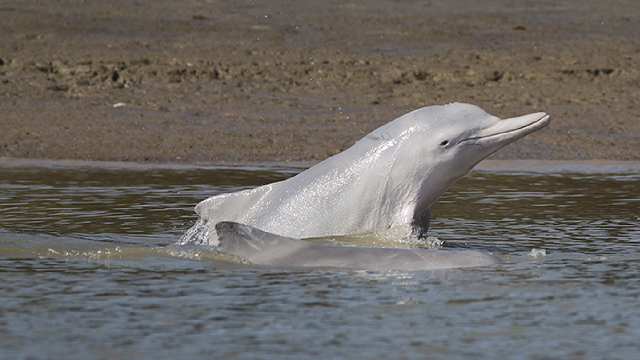Beached as bro! Dolphins in Fitzroy River, Queensland chase fish onto muddy banks and beach themselves, before sliding back into the water.
Use this article to demonstrate an application of specific adaptations and changing ecosystems to students in years 5, 7, 9, and 10 studying Biological and Earth and Space Sciences.
Word Count / Video Length: 470 / 1:57 mins
Why This Matters: Dolphins keep surprising with their cleverness (and risk-taking).
When it comes to finding food, Dolphins are pretty ingenious. They cover their noses in sea sponges to protect their snouts and uncover more fish hiding in the sandy sea floor. Others use shells as filters, carrying them through the water before draining them at the surface, leaving the delicious fish stranded inside.
They even co-operate with humans on fishing duty.
Now, for the first time, Australian researchers have seen dolphins intentionally beaching themselves while catching fish.
The strategy comes with obvious risks, but done well, the dolphins can trap fish along the muddy shorelines of the Fitzroy River in Queensland.
It was filmed for the first time by Southern Cross University researcher Daniele Cagnazzi. He was tracking and observing a pod of humpback dolphins in the Fitzroy River using a drone when he captured the tactic.
Strand feeding a risky but important part of their day
So-called “strand feeding” has been documented in very few locations overseas, primarily by bottlenose dolphins, says Cagnazzi.
“Strand feeding occurs where dolphins patrol the mud banks in search of prey. Once the prey has been localised a dolphin swims at high speed toward the shore, catches the fish in its mouth and remains stranded for a short time before sliding gently back into the water.”

The strategy seems intentional. The strand feeding only occurs at low tide when the mud banks are exposed, and only in areas where the bank is steep enough to help the dolphin slide back into deeper water. The dolphins can end up either partially or fully out of the water.
“This type of feeding is very risky, as dolphins run the risk of remaining stranded. However, since this behaviour is routinely repeated it must provide an important proportion of their daily feeding needs – dolphins must consume 4-6 per cent of their own body weight in fish each day.”
It’s not known if all humpback dolphins use strand feeding, or just the group seen.
“This strand feeding behaviour is conducted primarily by a very well-known family group of humpback dolphins who we’ve identified as long-term residents in the Fitzroy River,” says Cagnazzi.
According to Cagnazzi, changes to the habitat caused by more frequent floods and increased amounts of sediment being washed down the river may affect the ability of dolphins to strand feed. And that could impact their daily food intake.
It’s also not known if strand feeding is culturally transmitted – a taught behaviour communicated from one generation to the next. Cultural transmission occurs with dolphins who use sea sponges, for example. Cagnazzi hopes photographic and genetic data can shed light on the question.
Australian humpback dolphins are listed as ‘Vulnerable’ in Queensland and in the International Union for Conservation of Nature ‘Red List’ of threatened species.
Login or Sign up for FREE to download a copy of the full teacher resource





